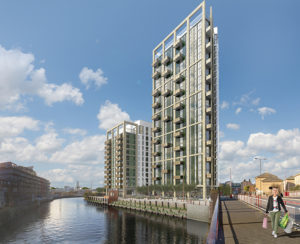 The residential property industry has won a major victory in securing a policy change that will give the rental market its own affordable housing classification in London.
The residential property industry has won a major victory in securing a policy change that will give the rental market its own affordable housing classification in London.
The move is expected to unlock thousands of rental homes across the capital and could unleash billions in investment. It could also be fundamental in advising national planning policy for the sector.
The Supplementary Planning Guidance, due to be signed off on Monday by London mayor Sadiq Khan, will provide official direction that rental schemes do not need to have the same affordable requirements as housing for sale.
Critically, it will allow discounted market rent to be used for the entire affordable contribution, with all units remaining under the owner’s control.
“For years we have been lobbying government about the potential of build to rent, and it looks like they have listened,” said Duncan Salvesen, director at Dorrington.
“Potentially, with the new rhetoric from central government about mixed tenures, it could even unlock a new wave of investment into the sector, as stability and certainty is increased.”
What will define a build-to-rent scheme
• A minimum of 50 units, all for rent
• A level of onsite management and services provided
• Covenanted as rental for at least 15 years
• Unified ownership and management
• Professional and on-site management.
• Three year assured short hold tenancy
• No letting fees
• Membership of an ombudsman scheme
The guidance will also confirm Khan’s flat 35% affordable requirement for homes built for sale, as revealed by Estates Gazette in July. If developers meet this target they will not have to undertake viability assessments.
The GLA accepts PRS schemes cannot reach a level of 35% affordable. As a result, rental schemes will be subject to a viability assessment to establish the percentage of affordable units and the rent they will pay, and will have to define a clawback if the rental covenant is broken.
The discounted market rent will be set at London Living Rent, defined as a third of the local income, though the GLA is understood to be willing to be flexible depending on the length of the rental covenant.
Rental schemes would be given a separate classification, provided they meet a series of criteria (see above).
The guidelines will be similar to those used on Essential Living’s Creekside Wharf Development in Greenwich (pictured). It was the first to agree a tenure-blind discounted market rent percentage that remained under the developer’s control.
Scott Hammond, managing director at Essential Living, said the GLA’s pragmatism would encourage new institutional money.
While the guidelines recognise build to rent as a separate type of asset, they have not defined it as a separate use class, which would have deterred institutional investors.
However, the guidelines do not allow for units smaller than the 420 sq ft minimum space requirement.
The British Property Federation had proposed a 10% reduction in minimum space to increase viability, offset by the provision of amenity space. Khan and deputy mayor James Murray were said to be opposed.
Ian Fletcher, director of policy at the BPF, said: “London’s housing problems are unique in their scale, but hopefully some of the steps the GLA is taking can also be translated into the eagerly awaited government housing white paper.”
• To send feedback, e-mail alex.peace@estatesgazette.com or tweet @egalexpeace or @estatesgazette
• To send feedback, e-mail Louisa.Clarence-Smith@estatesgazette.com or tweet @LouisaClarence or @estatesgazette











